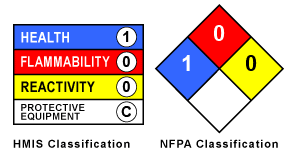What is it?
Ammonium nitrate is an odorless, colorless or slightly hazy liquids produced by the reaction of ammonia and nitric acid.
How is it used?
Ammonium nitrate is an important compound of many fertilizer mixtures. It provides a source of nitrogen to plants, which increases growth and crop yields. Small quantities of ammonium nitrate are also an additive for mining explosives and other non-agricultural uses.
What are the potential hazards?
Under normal transport conditions, AN20 is between 75C (167F) and 135C (275F). Therefore thermal injuries are possible. Additionally, inhalation of high concentrations of AN20 vapor can cause respiratory tract irritation with symptoms may include: coughing, sore throat, shortness of breath, or even suffocation. Repeated or prolonged inhalation of AN20 vapors may produce severe irritation of the respiratory tract, headache, nausea or weakness. When swallowed in high concentrations AN20 may cause headache, dizziness, abdominal pain, vomiting, bloody diarrhea, weakness, a tingling sensation, heart and circulation irregularities, convulsions, collapse, and suffocation.
Ammonium nitrate forms a mild acid when mixed with water. This acid can cause irritation to the eyes, nose and skin.
Is it flammable or explosive?
Ammonium nitrate is non flammable, but when exposed to extreme heat it can decompose forming a visible cloud of ammonia, carbon dioxide, and nitrogen oxides. AN20 can form an explosive mixture if it comes in contact with organic materials.
What are the emergency response procedures?
In the event of a spill or accidental discharge, the emergency responders will collect the spilled material in suitable containers for reuse or disposal.
What to do if you are exposed.
Eye Contact:
Check for and remove contact lenses. Immediately flush with running water for at least 15 minutes, keeping the eye lids open. Obtain immediate medical attention if irritation persists.
Skin Contact:
Wash irritated skin with soap and water. Dry and cover skin with a good quality skin lotion. If irritation persists seek medical attention immediately.
Minor Inhalation:
Loosen tight clothing. Rest in a well ventilated area. If irritation or symptoms persist obtain medical attention.
Severe Inhalation:
Using appropriate respiratory protection evacuate the affected individuals to a safe area as soon as possible. Loosen tight clothing around the person’s neck and waist. If breathing is difficult administer oxygen. If the person is not breathing perform artificial respiration and obtain medical attention.
Ingestion:
If conscious, drink several glasses of water or milk and induce vomiting. Never give anything by mouth to an unconscious person. Lower the head so that the vomit will not reenter to mouth or throat. Call a physician or poison control center and seek immediate medical attention.
What to do in the event of a spill.
Unless you are told by authorities:
When you have been advised of an ALL CLEAR by local authorities, open your house to air it out.
